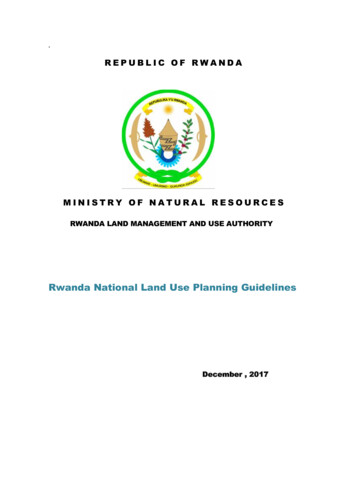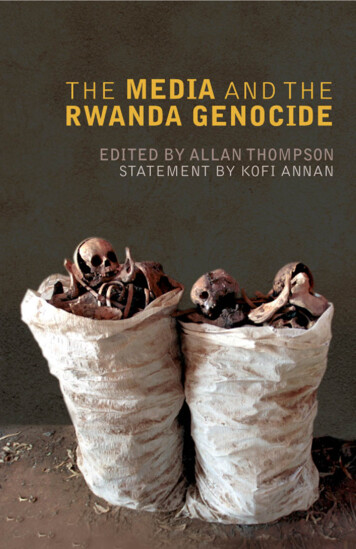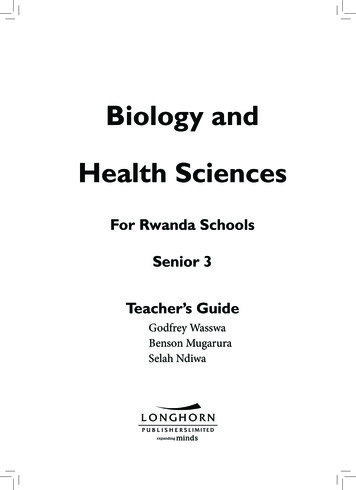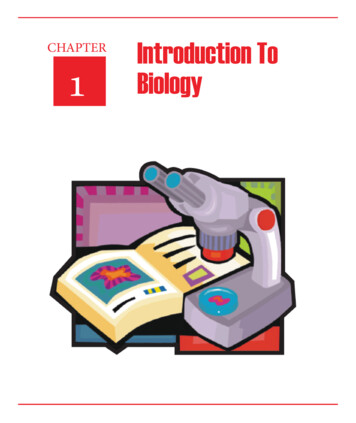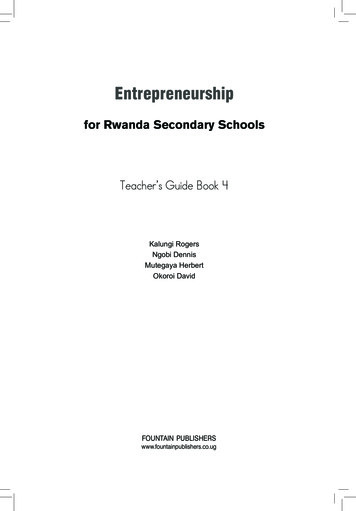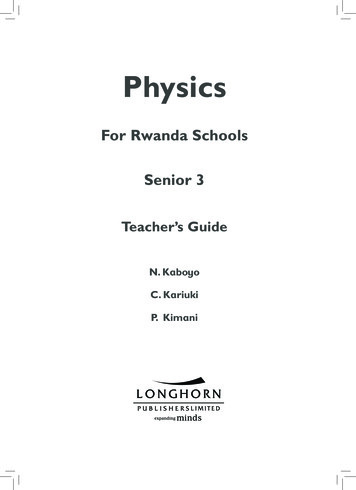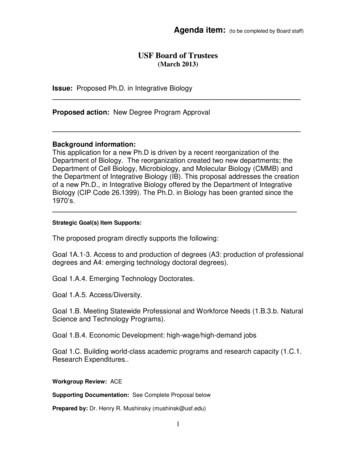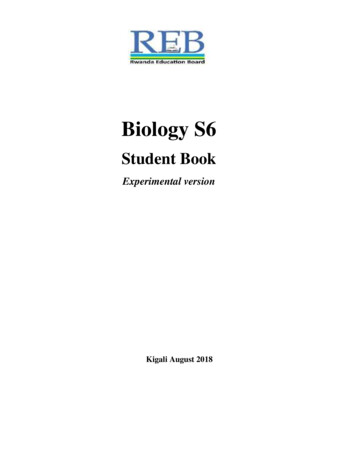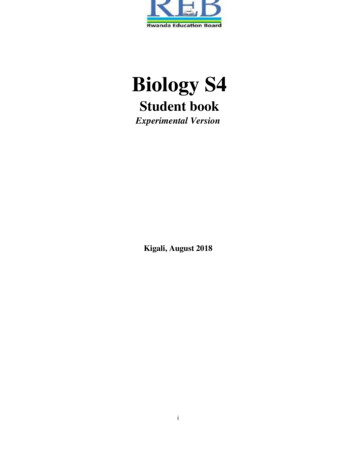
Transcription
Biology S4Student bookExperimental VersionKigali, August 2018i
Copyright 2018 Rwanda Education BoardAll rights reserved.This document is the property of Rwanda Education Board.Credit should be given to REB when the source of this book is quoted.ii
Table of contentTable of content .iiiUNIT 1 INTRODUCTION TO BIODIVERSITY . 11.1 Meaning of key ecological terms and biodiversity .41.2 Identification of biodiversity .81.3 Calculation of Simpson’s index .111.4Sampling techniques to assess the distribution and abundance of organisms .31.5 Pearson’s linear correlation.8End of unit assessment 1 .10UNIT 2 INTRODUCTION TO CLASSIFICATION . 112.1 Taxonomic hierarchy .122.2 Binomial nomenclature .122.3 Three domains; Archaea, Bacteria and Eukarya. .132.4 Five kingdoms of organisms .152.5 Economic importance of bacteria .192.6 Common bacterial diseases in plants and animals .212.7 Structure and classification of Viruses .232.8 Dichotomous key of identification of organism .25End of unit assessment 2 .29UNIT 3 MICROSCOPY . 323.1 Compound Light Microscope .333.2 Magnification and resolution of a compound light microscope. .36b)Microscopic observation .373.3 Electron microscopes.39End of unit assessment 3 .43UNIT 4 CELL STRUCTURE AND SPECIALIZATION . 454.1 Ultra-structure of a cell .464.2 Prokaryotic cells .484.4 Membrane structure .574.5 Specialized cells.62End of unit assessment 4 .69UNIT 5 DIVERSITY OF SPECIALIZED TISSUES . 715.1 Specialized plant tissues .72iii
5.2 Animal tissues .825.3 Levels of organization: cell, tissue, organ and system .945.4 Advantages and disadvantages of being Unicellular or Multicellular .96End of unit assessment 5 .98UNIT 6 TESTING FOR BIOLOGICAL MOLECULES . 996.1 Test for carbohydrates .1006.2 Test for proteins.1036.3 Test for lipids .1046.4 Test for vitamin C (Ascorbic Acid). .105End of unit assessment 6 .107UNIT 7 CARBOHYDRATES AND LIPIDS . 1097.1 Classes of monomers .1107.2 Ring form of α-glucose and β-glucose .1107.3 Formation and breakdown of glycosidic bonds. .1137.4 Polysaccharides: starch, glycogen and cellulose .1157.5 Lipids .118End of unit assessment 7 .121UNIT 8 PROTEINS AND WATER . 1228.1 Proteins .1228.2 Structure and denaturation of proteins .1258.3 Water .130End of unit assessment 8 .133UNIT 9 VITAMINS AND MINERALS . 1349.1 Mineral nutrients in humans .1349.2 Classification of mineral nutrients .1359.3 Sources, functions and deficiency symptoms of mineral nutrients in humans .1369.4 Vitamins and the classification of vitamins. .1429.5 Sources, functions and symptoms of vitamin deficiency .143End of unit assessment 9 .147UNIT 10 ENZYMES . 15010.1 Criteria for naming enzymes .15110.2 Characteristics of enzymes .15310.3 Mode of action of enzymes .155iv
10.4 Factors affecting enzyme action .15710.5 Importance of enzymes in living organisms .16410.6 Enzymes technology .165End of unit assessment 10 .167UNIT 11 PRINCIPLES OF GAS EXCHANGE SYSTEMS . 16911.1 Relationship between size and surface area to volume ratio .17011.2 Characteristics of gas exchange surfaces.17111.3 Modifications of gaseous exchange surfaces to speed up the rate of gaseous exchange indifferent organims .17211.4 Smoking and related risks .177UNIT 12 GAS EXCHANGE IN PLANTS. . 18112.1 Structure of stoma .18212.2 Theories used to explain the mechanism of opening and closure of stomata .18412.3 Structural adaptations and function of stomata, lenticels and breathing roots. .186End of unit assessment 12 .189UNIT 13 GROWTH AND DEVELOPMENT IN PLANTS AND ANIMALS. . 19213.2 Types and stages of germination. .19513.3 Primary and secondary growth .19713.4 Determination of growth .19913.5 Phytohormones .20013.6 Plant movements and photoperiodism .20113.7 Metamorphosis and growth patterns in insects and amphibians .208End of unit assessment 13 .212UNIT 14 SUPPORT AND LOCOMOTION . 21314.2 Support and locomotion in non-muscular organisms .21614.3 Support and locomotion in fish .21814.4 Support and locomotion in terrestrial animals .22014.5 Flight through air by birds and insects .22314.6 Hopping locomotion in grasshoppers and toads .224End of unit assessment 14 .226UNIT 15 CLASSIFICATION AND PATTERNS OF DISEASE . 22715.1 Germ theory of diseases .22715.2 Classification of diseases .22915.3 Common infectious diseases .235v
15.4 Health and community: criteria for good housing .24715.5 Public health services .249End of unit assessment 15 . 252UNIT 16 ASEXUAL REPRODUCTION IN PLANTS . 25316.1 Asexual reproduction .25316.2 Types of asexual reproduction.25416.3 Advantages and disadvantages of asexual reproduction .25616.4 Vegetative and artificial propagation in flowering plants .25716. 5 Application of artificial propagation in production of improved varieties of plants .260End of unit assessment16 . 262UNIT 17 SEXUAL REPRODUCTION IN PLANTS . 26317.1 Alternation of generations in bryophytes and pteridophytes .26417.2 Types and structures of flowers .26817.3 Pollination and double fertilization in flowering plants.27217.4 Structures and types of fruits and seeds .27817.5 Fruits and seeds dispersal with their adaptations .283End of unit assessment 17 . 285UNIT 18 MICROBIOLOGY . 28818.1 Introduction to microbiology.28918.2 The structure and life cycle of Escherichia coli .29218.3 The structure and life cycle of viruses .29418.4 Moulds .30118.5 Penicillium and Saccharomyces .30518.6 Protozoa that cause disease.307End of unit assessment18 . 316UNIT 19 CULTURING MICROORGANISMS . 31819.1 Requirements for culturing of microorganisms.31819.2 Culture media .32019.3 Aseptic technique. .32319.4 Population growth of bacteria .32819.5 Staining of bacteria.330End of unit assessment 19 . 334UNIT 20 BIOTECHNOLOGY AND ITS APPLICATION . 335vi
20.1 Role of bacteria in Biotechnology and genetic engineering .33620.2Immobilization of enzymes .33820.3 Application of enzyme in technology. .34420.4 Fermentation and fermenters and production of penicillin .34820 5 Antibiotic resistance and implications of antibiotic use .35320.6 Biogas production .356End of unit assessment 20 . 359REFERENCES . 360vii
UNIT 1 INTRODUCTION TO BIODIVERSITYKey Unit CompetenceTo be able to explain how diversity is threatened by climate change and human activitiesLearning objectivesBy the end of this unit, I should be able to:-Define the terms: species, ecosystem and niche.-Explain that biodiversity is considered at three different levels-Evaluate the consequences of loss of biodiversity.-Characterize the biotic and abiotic components that define Rwanda’s ecosystems (example:freshwater, marine, and terrestrial).-Apply Simpson’s Index of Diversity.-Explain the importance of random sampling in determining the biodiversity of an area.-Use suitable survey methods such as frame quadrats, line and belt transects to assess thedistribution and abundance of organisms in a local area.-Use Pearson’s linear correlation to analyze the relationships between the distribution andabundance of species and abiotic or biotic factors.-Recognize that the biodiversity of the earth is threatened by human activities and climatechange1
Introductory activity: Biodiversity of RwandaRead the following text and answer the questions that followRwanda is located at the heart of the Albertine Rift eco-region in the western arm of the Africa’sRift Valley. Habitats of Rwanda are equally varied, ranging from Afro-Montana ecosystems inthe northern and western regions to lowland forests, savannah woodlands and savannahgrasslands in the southern and eastern regions. There are other habitats around volcanic hotsprings and old lava flows, especially in the northern and western part of the country. Rwandaalso has several lakes and wetlands which are rich in different species. Though not yet wellsurveyed, all these ecosystems host a rich variety of fauna and flora and micro-organisms. Thisrich biodiversity is mainly conserved in protected areas including three national parks, naturalforests and wetlands. These cover almost 10 percent of the national territory while the rest ofthe country is densely populated (507 people per square kilometer in 2018).Many tourists visit Rwanda for its beautiful environment and biodiversity made of differentspecies of plants and animals such as Aloe vera (Igikakarubamba), Muringa oleifera (Muringa),Phaseolus vulgaris (common bean), Nymphaea thermarum (Endemic plant species that cannotbe met elsewhere in the world, only found in Mashyuza minor locality harbors), Colobuspolykoma (White-black colobus monkey), Gorilla gorilla (mountain gorilla) bird Laniariusmufumbiri (Bird species mainly found in Rweru- Mugera wetland),etc.2
The most attracting species in Rwanda is Gorilla gorilla whose habitat is the mountains ofBirunga where they make a large population. Another natural forest, Nyugwe National Parkis a terrestrial ecosystem that contains a large community of different plants and animals.Rwanda also has different lakes such as Muhazi and Rumira. They are aquatic ecosystemsmade of few species of fish, such as tilapias. Tilapias from Lake Muhazi are small, black andbony fish while those from Lake Rumira look red, big and soft. Tilapias from both lakes stillbelong in the same species but show variations.Many species of animals and plants have been discovered in Rwanda but some species alsodisappeared. Today the big garden snails known as Achatina achatina have become rare inBugesera. Other people poached Rhinoceros alba living in Savanah of Akagera National Park.Honey bees, butterflies and grasshoppers are small in size but still important for differentecosystem services. Each organism is important for its niche in ecosystem. We need to identifyand protect the biodiversity of our ecosystem. Many tourists enjoy visiting Rwanda for itsbiodiversity.1) Name the species not found elsewhere that attract the tourists and locate where it isfound.2) Mashyuza is a minor locality in western province in Rusizi district that contributes tobiodiversity of Rwanda. Give any other two locations.3) Define each of the following biological terms and give an example from the textabove:(a) Species (b) Population (c) Community (d) Habitat (e) Ecosystem (f)Variation (g) Niche4) What causes some species to become extinct?5) What can be the consequences of the loss of some species from our biodiversity?6) Do you support tourism in Rwanda? Give a reason to justify your answer.3
1.1 Meaning of key ecological terms and biodiversityActivity 1.11) What do you understand by the following terms: biodiversity, species, niche,population, and community?2) Differentiate between ecological niche and habitat.1.1.1 Key ecological termsSpecies is a group of closely related organisms which are capable of interbreeding to produce fertileoffspring. Occasionally two organisms which are genetically closely related but not of the samespecies can interbreed to produce infertile offspring. For example:-A cross between a donkey and a horse produces a mule, which is infertile. Thus, a donkeyand a horse do not belong to the same species- Lions and tigers belonging in different species. However, when a male tiger mates with afemale lion they can have fertile offspring called tiglons, although the offspring of femaletigers and male lions called ligers are not fertileNote that normally, tigers are forest dwellers and lions are plains dwellers and they are ecologicallyisolated. Breeding has only been observed in captivity.An ecological population is a group of individuals of the same species which live in a particulararea at any given time.An ecological community consists of populations of different species which live in the same placeat the same time, and interact with each other.A habitat is a specific area or place in which an individual organism lives. When a habitat is verysmall it is regarded as a microhabitat. Most ecosystems contain several habitats, and one speciescan have more than one habitat constituting its geographic range.An ecological niche is the status or the role of an organism in its habitat or the mode of life of anorganism within its habitats. For example, insects are pollinating agents and preys of insectivores.A Biotic factor are non-living physical aspects of the environment such as the sunlight, soil,temperature, wind, water, and air.Biotic factors are the living organisms in the environment. They include organisms and theirinteractions with each other.An ecosystem is a natural unit consisting of biotic and abiotic factors through which energy flowsand nutrients recycle. In an ecosystem, nutrients pass between different organisms in definitepathways. For example, nutrients in the soil are taken up by plants, which are then eaten byherbivores, which in turn may be eaten by carnivores and recycled by decomposers.4
A biome is a group of ecosystems that have the same climate and similar dominant communities.The highest level of organization is the entire biosphere.The Biosphere is the whole of the earth’s surface, the sea and the air that is inhabited by livingorganisms. The biosphere is made up of all ecosystems.1.1.2. Biodiversity5
6
Figure 1.1: Varieties of species in ecosystemsBiodiversity is defined as the full range of variety and variability within and among livingorganisms and the ecological complexes in which they occur.Self-assessment 1.11) Describe the two main components of an ecosystem.2) Hippopotamus has different habitats. It was found that the resting habitat is different fromthe mating habitat, and these two habitats are different from the area where this animal getsfood. Explain the ecological term given to this set of habitats.7
1.2 Identification of biodiversityActivity 1.2Use books or other sources of information to answer the followings questions:1) What kinds of initiatives and incentive mechanisms are put in place by the Government ofRwanda to motivate local community biodiversity conservation?2) Describe different ways used to identify biodiversity.3) Discuss the values of biodiversity and ecosystem services in Rwanda.4) Evaluate the contribution of biodiversity to human well-being.1.2.1. Categories of biodiversityBiodiversity can be categorized into three groups:-Genetic diversity: the combination of different genes found within a population of a singlespecies, and the patterns of variation found within different populations of the same species.- Species diversity: the variety and abundance of different types of organisms which inhabitan area.- Ecosystem diversity: the variety of habitats that occur within a region, or within the mosaicof patches found within a landscape.1.2.2. Importance of biodiversityBiodiversity contributes to ecosystem goods and services. The ecosystem goods and servicesinclude:-Provision of food, air, fire wood, medicines(Fig.1.2), energy, fresh water.-Cultural or aesthetic service recreation, ecotourism, cultural and religious inspiration.Nutrient cycling such carbon, water and nitrogen cycles by microorganisms and primary productionby photosynthesis.ABCDFigure 1.2: Some of the common medicinal plants (A: Aloe vera, B: Spinacia oleracea,C: Datura stramonium, D: Camellia sinensis)8
1.2.3. The threats and consequences of biodiversity loss1.2.3.1. Causes of biodiversity lossThe main causes of biodiversity loss can be attributed to the influence of human activities onecosystems. Threats to biodiversity include:a) Habitat loss and the degradation of the environmentThe habitat loss and the degradation of the environment occur in different ways. The mostoccurring, are tree cutting, agriculture and fires (Figure1.3). These human activities lead to thealteration and loss of suitable habitats for biodiversity. As a consequence, there is a loss of plantspecies as well as the decrease in the animal species associated to this plant diversity.Figure 1.3: Deforestation and bush burning cause biodiversity lossb) Introduction of invasive alien species and genetically modified organismsSpecies originating from a particular area are harmful to native species also called endemic specieswhen they are introduced into new natural environments. They can lead to different forms ofimbalance in the ecological equilibrium, so that endemic species may fail to compete withintroduced species, and they may affect the abundance and distribution in natural habitat.c) PollutionHuman activities such as excessive use of fertilizers, and increased pollutants from industries anddomestic sewage affect biodiversity. They contribute to the alteration of the flow of energy,chemicals and physical constituents of the environment and hence species may die as a result oftoxic accumulation.d) Overexploitation of natural resourcesIncreased hunting, fishing, and farming in particular areas lead to the decrease and loss ofbiodiversity due to excessive and continuous harvesting without leaving enough time for theorganisms to reproduce and stabilize in their natural habitat.9
e) Climate changeThis is a change in the pattern of weather, related changes in oceans, land surfaces and ice sheetsdue to global warming resulting from man’s activities. Increasing global temperatures have resultedinto melting of icebergs raising sea levels and so flooding coastal areas eventually affecting theniche.
2 Introductory activity: Biodiversity of Rwanda Read the following text and answer the questions that follow Rwanda is located at the heart of the Albertine Rift eco-region in the western arm of the Africa's
